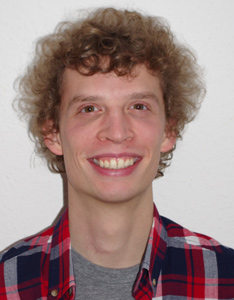| M. Sc. Felix Kleißler | |||||||
|
Publications(up to 2017)
-
High numerical aperture (NA = 0.92) objective lens for imaging and addressing of cold atoms, Opt. Lett. 42, 1043 (2017)arXivBibTeX ABSTRACT »
ABSTRACT »We have designed, built, and characterized a high- resolution objective lens that is compatible with an ultra-high vacuum environment. The lens system ex- ploits the principle of the Weierstrass-sphere solid immersion lens to reach a numerical aperture (NA) of 0.92. Tailored to the requirements of optical lattice experiments, the objective lens features a relatively long working distance of 150 μm. Our two-lens design is remarkably insensitive to mechanical tolerances in spite of the large NA. Additionally, we demonstrate the application of a tapered optical fiber tip, as used in scanning near-field optical microscopy, to measure the point spread function of a high NA optical system. From the point spread function, we infer the wavefront aberration for the entire field of view of about 75 μm. Pushing the NA of an optical system to its ultimate limit enables novel applications in quantum technolo- gies such as quantum control of atoms in optical mi- crotraps with an unprecedented spatial resolution and photon collection efficiency.
-
Assembly and Characterization of a High Numerical Aperture Microscope for Single Atoms, (2014), Master thesisBibTeX ABSTRACT »This master thesis investigates the optical imaging properties of a state of the art in-house developed objective for the observation of single atoms trapped in a two-dimensional spin-dependent optical lattice. After the successful assembly of the objective lenses into a ceramic holder two different approaches for the characterization are presented. First a wave-front analysis for the estimation of the root-mean-square deviation to a planar reference using a Shack-Hartmann sensor and a Shearing interferometer is performed. In the second approach the imaging of a point-like light-source is utilized to determine the point-spread-function of the objective. The production of the probes is inspired by methods of optical microscopy in the nano-scale regime like Total-Internal-Reflexion-Fluorescence- and Scanning-Nearfield-Optical-Microscopy. Self-written MATLAB-routines are used to extract quantitative information on the imaging system. The analysis in this work shows that the objective can operate close to diffraction limit with a numerical aperture of 0.9. Numerically calculated point-spread-functions are compared to the measurements to explain the small deviations to the perfect Airy pattern. A very good agreement has been found between the point-spread-function calculated numerically and that measured in the characterization set-up.
ABSTRACT »This master thesis investigates the optical imaging properties of a state of the art in-house developed objective for the observation of single atoms trapped in a two-dimensional spin-dependent optical lattice. After the successful assembly of the objective lenses into a ceramic holder two different approaches for the characterization are presented. First a wave-front analysis for the estimation of the root-mean-square deviation to a planar reference using a Shack-Hartmann sensor and a Shearing interferometer is performed. In the second approach the imaging of a point-like light-source is utilized to determine the point-spread-function of the objective. The production of the probes is inspired by methods of optical microscopy in the nano-scale regime like Total-Internal-Reflexion-Fluorescence- and Scanning-Nearfield-Optical-Microscopy. Self-written MATLAB-routines are used to extract quantitative information on the imaging system. The analysis in this work shows that the objective can operate close to diffraction limit with a numerical aperture of 0.9. Numerically calculated point-spread-functions are compared to the measurements to explain the small deviations to the perfect Airy pattern. A very good agreement has been found between the point-spread-function calculated numerically and that measured in the characterization set-up.
Research areas
Our group
Publications
Former research topics
Teaching
Further information
Login
Colloquia
- Curtius Lectures
- 03/05/22 - 06/05/22










